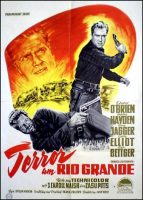Denver and Rio Grande movie storyline. In the late 1870s, chief engineer Gil Harkness and construction foreman Jim Vesser are surveying a new route for the Denver and Rio Grande Railroad (D&RG) through the Royal Gorge in Colorado. Vesser learns that a crew from the competing Cañon City & San Juan Railroad is also in the gorge and confronts former friend Bob Nelson and his unscrupulous boss, McCabe.
McCabe shoots Nelson in the back during a fight but he and crony Johnny Buff blame Vesser, who thinks he accidentally shot Nelson while stunned from a blow. Linda Prescott, the secretary of D&RG president General William J. Palmer, believes Vesser to be a cowardly killer. An injunction stops work by the D&RG in the gorge and Vesser suggests they run the CC&SJ men “out on a pole.” Linda, who is actually Nelson’s sister and is spying for McCabe after being told by him that Vesser murdered her brother, angrily accuses him of acting above the law.
Vesser talks Harkness into defying the injunction. When he enters the camp saloon to bring the men back to work, one of McCabe’s agitators sparks a brawl over not being paid. Palmer obtains payroll money in Denver, but the train returning him to the construction camp is robbed by three men, who shoot Palmer’s accountant.
Vesser returns to the saloon, sees two men gambling with a lot of cash when everyone else is broke and accuses them of robbing the payroll. They try to flee towards the CC&SJ camp and a gunfight ensues. Vesser kills one and wounds the other, who Palmer identifies as one of the robbers but says that the unknown third robber is the man who murdered his accountant. Vesser confronts Linda, revealing that he saw her riding in the direction of McCabe’s camp, but she dismisses his insinuations.
The injunction is lifted but Palmer announces he must go to Denver to keep the company out of receivership (and takeover by the CC&SJ). Linda reveals his plans to McCabe, who assembles his drunken thugs to prevent Palmer from getting to Denver by stealing a D&RG train and seizing all its stations to block the tracks.
A D&RG telegrapher warns Palmer, who rallies his men to fight McCabe’s. Vesser, Palmer and the D&RG men barrel through the blockade. Vesser and Harkness uncouple the engine from the rest of their train and allow it to crash head on into the stolen train to stop it from killing all of the others. Linda has doubts about McCabe after the violence and admits everything, but Palmer lets her go free.
Denver and Rio Grande is a Technicolor western film, directed by Byron Haskin and released by Paramount Pictures in 1952. The film is a dramatization of the building of the Denver and Rio Grande Railroad, which was chartered in 1870. It was filmed in the summer of 1951 on location on actual D&RG track (now the Durango and Silverton Narrow Gauge Railroad) near Durango, Colorado.
The film’s storyline is a fictional account based on two factual right-of-way struggles in 1878-1879 between the D&RG and the Atchison, Topeka and Santa Fe Railway (here the Cañon City & San Juan RR: across the Raton Pass from Trinidad, Colorado to Raton, New Mexico, where an armed confrontation actually took place, and the “Royal Gorge War” over a route between Cañon City and Leadville, Colorado.”
Filming began shortly after the release of Santa Fe, starring Randolph Scott. which interpreted the railroad war from the point of view of the AT&SF. Santa Fe, however, had been filmed in Prescott, Arizona, without access to the actual locations, and portrayed the D&RG as an honorable competitor. Both films followed an entirely fictional depiction in the 1950 western A Ticket to Tomahawk, which was shot on the same Silverton Line trackage as Denver and Rio Grande.
Denver and Rio Grande (1952)
Directed by: Byron Haskin
Starring: Edmond O’Brien, Sterling Hayden, Kasey Rogers, Dean Jagger, Lyle Bettger, J. Carrol Naish, Zasu Pitts, Tom Powers, Robert Barrat, Paul Fix, Don Haggerty, James Burke
Screenplay by: Frank Gruber
Production Design by:
Cinematography by: Ray Rennahan
Film Editing by: Stanley E. Johnson
Costume Design by: Edith Head
Set Decoration by: Sam Comer, Bertram C. Granger
Art Direction by: Franz Bachelin, Hal Pereira
Music by: Paul Sawtell
MPAA Rating: None.
Distributed by: Paramount Pictures
Release Date: May 16, 1952
Views: 193

